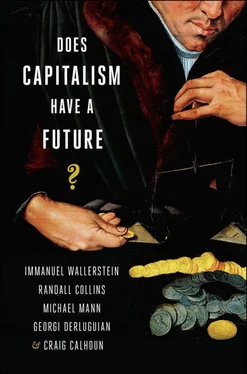Immanuel Wallerstein - Does Capitalism Have a Future?
Здесь есть возможность читать онлайн «Immanuel Wallerstein - Does Capitalism Have a Future?» весь текст электронной книги совершенно бесплатно (целиком полную версию без сокращений). В некоторых случаях можно слушать аудио, скачать через торрент в формате fb2 и присутствует краткое содержание. Город: New York, Год выпуска: 2013, ISBN: 2013, Издательство: Oxford University Press, Жанр: Публицистика, sci_economy, на английском языке. Описание произведения, (предисловие) а так же отзывы посетителей доступны на портале библиотеки ЛибКат.
- Название:Does Capitalism Have a Future?
- Автор:
- Издательство:Oxford University Press
- Жанр:
- Год:2013
- Город:New York
- ISBN:978-0-19-933084-3
- Рейтинг книги:5 / 5. Голосов: 1
-
Избранное:Добавить в избранное
- Отзывы:
-
Ваша оценка:
- 100
- 1
- 2
- 3
- 4
- 5
Does Capitalism Have a Future?: краткое содержание, описание и аннотация
Предлагаем к чтению аннотацию, описание, краткое содержание или предисловие (зависит от того, что написал сам автор книги «Does Capitalism Have a Future?»). Если вы не нашли необходимую информацию о книге — напишите в комментариях, мы постараемся отыскать её.
Does Capitalism Have a Future? — читать онлайн бесплатно полную книгу (весь текст) целиком
Ниже представлен текст книги, разбитый по страницам. Система сохранения места последней прочитанной страницы, позволяет с удобством читать онлайн бесплатно книгу «Does Capitalism Have a Future?», без необходимости каждый раз заново искать на чём Вы остановились. Поставьте закладку, и сможете в любой момент перейти на страницу, на которой закончили чтение.
Интервал:
Закладка:
The antisystemic movements of the New Left gained traction wherever they could tap (often without fully realizing it) into latent social tensions generated by conjunctures of many factors: industrial recessions, demographic transitions, the changing social geography of urban neighborhoods, repressed ethnic memories, even the sectarian religious fervors or the regional elite factionalisms previously marginalized by modernistic planners of new towns, industries, and states. Profoundly changing the historical pattern of revolutions, these anti-authority rebellions were diffuse, nonviolent in their preferred tactics, and centered on the demands for greater autonomy from bureaucratic regimentation and recognition for the many and greatly varied status groups that were now called identity politics. This meant a departure from the Marxian categories of economic classes as the basis of social struggle. What gave a semblance of common purpose to the disparate protests of the sixties was the universal presence of bureaucratic establishments, oftentimes presided over by the paternalistic and patronizing Big Bosses. For a short while, such situations were conducive to the sharply polarized confrontations of “us against them” performed in public spaces and on spectacularly massive scales. Recall the events of 1968 in the West, the tremendous anti-Shah marches in Iran during 1978–1979, the 1980 strikes in Poland and the 1989 rallies across the whole Soviet bloc, or, for that matter, the 2011 uprising against the Big Boss in Egypt.
The participants, commentators, and sympathetic researchers of these exuberant events focused overwhelmingly on the contentious side where all the energy and hope could be found. Contemporary analyses from the insurgent side typically ignored or took for granted what the embattled rulers were doing or actually not doing. In the majority of instances, bureaucratic establishments seemed oddly reluctant to unleash an all-out terroristic repression. This should seem quite startling because both “capitalist pigs” and “communist apparatchiks” certainly possessed the means and personnel for launching massive violence against unruly civilians in the manner of the interwar totalitarian decades. Grim exceptions still abounded in the stormy aftermath of 1968. We must not forget the brief throwbacks to European fascism that continued in Spain, Greece, and Turkey; Latin American dictatorships; the apartheid-era South Africa; coups and “emergencies” in Arab countries; and internal violence in the East Asian states of both communist and anticommunist persuasion, like Maoist China and South Korea under military rule. The immediate reasons for unleashing state terror in response to student-led activism were local and peculiar to each instance. Yet repression commonly occurred across the outlier world regions and semi-peripheral countries where states were inherently weaker and often newly established.
This contrast in the state reactions to protest points toward an important theory. In the West and in the Soviet bloc—but not in Latin America, Middle East, or East Asia—the political establishments by the 1970s had indeed become thoroughly bureaucratic. Their institutions and ruling personnel were forged in the enormous wartime mobilizations of the twentieth century and disciplined by the precarious balance of the Cold War. Their senior members still collectively remembered the run-away affair with fascist paramilitaries during the interwar period in Europe, or Stalinist purges, or the racial and labor conflict violence recurrently flaring up in twentieth-century America. Perhaps it was the overwhelmingly peaceful and civic tactics of New Left, in contrast to the revolutionary militias of Old Left, that denied the state security organs clear targets for violent confrontation. Perhaps the bureaucrats and politicians ensconced in highly institutionalized environments developed cautious dispositions that were conductive to avoidance of overt conflicts. Instead such “post-Machiavellian” rulers reckoned on the default bureaucratic tactic of muddling through. And this suggests an important and even hopeful insight. Leaping ahead, we should say that studying the conditions for violent action and its avoidance in modern bureaucratic states must be a priority for social science in the anticipation of bigger crises and possible revolutions.
In the seventies and eighties, establishmentarian politics of muddling through and evasion delivered a fix that has lasted until yesterday. The New Left movements flared up and burned out as fast as fireworks. But the damage was considerable, especially when viewed in the longer-run perspective. The discredited and momentarily disoriented rulers began shedding their erstwhile commitments to industrial modernization, full employment, and welfare. In the West political systems had enough strength and resources to do this in a controlled manner, all the while calling it a new age of postindustrialism, flexibility, and globalization. In the Soviet bloc the process got out of hand, causing panic in the political and industrial elites. The result was state fragmentation and colossal pillage. The dissident New Left had its Pyrrhic victory in the extinction of communism. But, unlike the Old Left which was an organized (more precisely, a bureaucratically organized) force, the insurgent energies of this new generation failed to translate into institutions and policies adequate to the tasks of seizing the power that was dropped on the floor. Moreover, the ensuing deindustrialization, and severe budget cuts in higher education, cultural institutions, and general welfare rapidly undid the bases of popular confidence and thus the bases of support for this new generation of antisystemic insurgents.
In the meantime a different kind of popular movement began emerging from the Right. The New Right snatched many of its tactics and even former activists from the dispirited New Left. This turn to the right marked the end of the long period dominated by class politics with its familiar symbols, tactics, and well-rehearsed rituals of bargaining. The political reaction flew the colors of identity, which introduced into politics a nastily passionate charge because matters of identity tend to be uncompromising and nonnegotiable. The New Right came in two varieties, though often meshing in practice: ethnopatriotic or religious-patriotic fundamentalism and libertarian market fundamentalism. Both called for the militant defense of fundamental matters of faith—or whatever was claimed to be the founding identities in their societies. Notice that both fundamentalisms directed their ire at state bureaucracies, blaming them for being too secular, removed, devious and taxing. It tells us something important about Christian, Muslim, Jewish, Buddhist, Hindu and other contemporary fundamentalisms that their suspicions and phobias virtually everywhere went hand-in-hand with extolling the virtues of small business, small town life, and the patriarchal family.
The Left was precipitously declining across the board, leaving its place in the popular imagination to be filled with either apathy or fundamentalist anger. This reversal in mass politics opened the window of opportunity for conservative factions among the Western capitalist elites. Neoliberalism, yet another misnomer, in fact grows from the old ideological belief of modern capitalists that everyone would eventually benefit from letting them do whatever they deem necessary in the pursuit and disposal of profits. World progress, the purported laws of human nature, and supreme rationality are but the nineteenth-century intellectual supports to this faith. The fundamentalist character of the neoliberal movement is revealed in its adamant refusal to recognize as capitalism anything except the purest unregulated markets—just as religious fundamentalists recognize only their own radical brand of faith as true religion. History, however, shows that the ideal type of free markets cannot be observed in any empirical situation; it is an ideological fantasy. Following in the footsteps of Fernand Braudel and Joseph Schumpeter, we argue that sustained profits always require a degree of state protection and market monopoly. Hegemonic monopoly is what in fact propelled the renewed surge of American power and finance at the turn of the twenty-first century. At the time Michael Mann and Immanuel Wallerstein publicly opposed the project for an American world empire, and both presented analytical arguments questioning its viability. [1] Michael Mann, Incoherent Empire . (London: Verso, 2003); Immanuel Wallerstein, The Decline of American Power . (New York: New Press, 2003).
There is now enough hard evidence to see how these predictions squared with reality.
Интервал:
Закладка:
Похожие книги на «Does Capitalism Have a Future?»
Представляем Вашему вниманию похожие книги на «Does Capitalism Have a Future?» списком для выбора. Мы отобрали схожую по названию и смыслу литературу в надежде предоставить читателям больше вариантов отыскать новые, интересные, ещё непрочитанные произведения.
Обсуждение, отзывы о книге «Does Capitalism Have a Future?» и просто собственные мнения читателей. Оставьте ваши комментарии, напишите, что Вы думаете о произведении, его смысле или главных героях. Укажите что конкретно понравилось, а что нет, и почему Вы так считаете.












